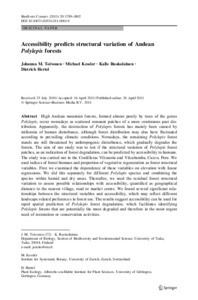Accessibility predicts structural variation of Andean Polylepis forests
Ruokolainen K; Toivonen JM; Hertel D; Kessler M
Accessibility predicts structural variation of Andean Polylepis forests
Ruokolainen K
Toivonen JM
Hertel D
Kessler M
SPRINGER
Julkaisun pysyvä osoite on:
https://urn.fi/URN:NBN:fi-fe2021042714654
https://urn.fi/URN:NBN:fi-fe2021042714654
Tiivistelmä
High Andean mountain forests, formed almost purely by trees of the genus Polylepis, occur nowadays as scattered remnant patches of a more continuous past distribution. Apparently, the destruction of Polylepis forests has mainly been caused by millennia of human disturbance, although forest distribution may also have fluctuated according to prevailing climatic conditions. Nowadays, the remaining Polylepis forest stands are still threatened by anthropogenic disturbance, which gradually degrades the forests. The aim of our study was to test if the structural variation of Polylepis forest patches, as an indication of forest degradation, can be predicted by accessibility to humans. The study was carried out in the Cordilleras Vilcanota and Vilcabamba, Cuzco, Peru. We used indices of forest biomass and proportion of vegetative regeneration as forest structural variables. First we examined the dependence of these variables on elevation with linear regressions. We did this separately for different Polylepis species and combining the species within humid and dry areas. Thereafter, we used the residual forest structural variation to assess possible relationships with accessibility, quantified as geographical distance to the nearest village, road or market centre. We found several significant relationships between the structural variables and accessibility, which may reflect different landscape related preferences in forest use. The results suggest accessibility can be used for rapid spatial prediction of Polylepis forest degradation, which facilitates identifying Polylepis forests that are potentially the most degraded and therefore in the most urgent need of restoration or conservation activities.
Kokoelmat
- Rinnakkaistallenteet [19207]
